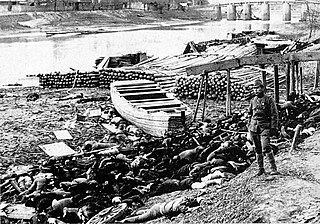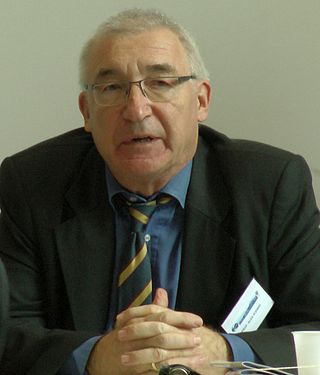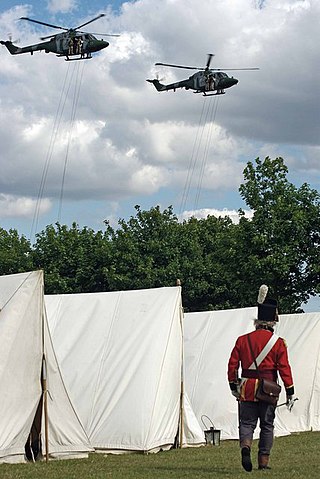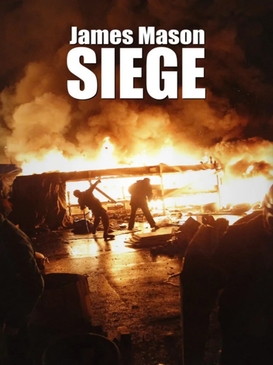
State terrorism refers to acts of terrorism which a state conducts against another state or against its own citizens.

Terrorism, in its broadest sense, is the use of violence against non-combatants to achieve political or ideological aims. The term is used in this regard primarily to refer to intentional violence during peacetime or in the context of war against non-combatants. There are various different definitions of terrorism, with no universal agreement about it. Different definitions of terrorism emphasize its randomness, its aim to instill fear, and its broader impact beyond its immediate victims.

Counterterrorism, also known as anti-terrorism, relates to the practices, military tactics, techniques, and strategies that governments, law enforcement, businesses, and intelligence agencies use to combat or eliminate terrorism.
There is no consensus, scholarly or legal, on the definition of terrorism.
A lone wolf attack, or lone actor attack, is a particular kind of mass murder, committed in a public setting by an individual who plans and commits the act on their own. In the United States, such attacks are usually committed with firearms. In other countries, knives are sometimes used to commit mass stabbings. Although definitions vary, most databases require a minimum of four victims for the event to be considered a mass murder.
Fourth-generation warfare (4GW) is conflict characterized by a blurring of the distinction between war and politics, and of the distinction between combatants and civilians.
Leaderless resistance, or phantom cell structure, is a social resistance strategy in which small, independent groups, or individuals, challenge an established institution such as a law, economic system, social order, or government. Leaderless resistance can encompass anything from non-violent protest and civil disobedience to vandalism, terrorism, and other violent activity.
George Joseph Michael is an American historian, political scientist, and writer. He is a professor at the criminal justice faculty of Westfield State University in Massachusetts, and previously served as associate professor of nuclear counterproliferation and deterrence theory at the Air War College and as associate professor of political science and administration of justice at The University of Virginia's College at Wise. He studies right-wing extremism, including the relationship between militant Islam and the far right, and is the author of Confronting Right-Wing Extremism and Terrorism in the USA (2003), The Enemy of My Enemy: The Alarming Convergence of Militant Islam and the Extreme Right (2006), Willis Carto and the American Far Right (2008), Theology of Hate: A History of the World Church of the Creator (2009), Lone Wolf Terror and the Rise of Leaderless Resistance (2012), and Extremism in America (editor) (2014). Professor Michael has also published research on SETI and is the author of Preparing for Contact: When Humans and Extraterrestrials Finally Meet (2014).

Alex Peter Schmid is a scholar in terrorism studies, who from 1999 to 2005 was Officer-in-Charge of the Terrorism Prevention Branch of the United Nations Office on Drugs and Crime in Vienna. He is particularly known for his work on the definition of terrorism.
David Charles Rapoport was a Professor Emeritus of Political Science at University of California, Los Angeles (UCLA) who focused on the study of terrorism.
New Zealand has experienced few terrorist incidents in its short history and the threat is generally regarded as very low. However, the Security Intelligence Service (SIS) has warned against complacency. This article serves as a list and compilation of past acts of terrorism, attempts of terrorism, and other such items pertaining to terrorist activities within New Zealand. Significant acts of terrorism include the bombing of the Rainbow Warrior in 1985, an act of state-sponsored terrorism by France, and the Christchurch mosque shootings in 2019, a far-right attack which resulted in 51 deaths and 40 injuries.

Marc Sageman is an American psychiatrist who is a former CIA Operations Officer based in Islamabad from 1987 to 1989, where he worked closely with Afghanistan's mujahedin. He has advised various branches of the U.S. government in the War on Terror. He is also a forensic psychiatrist and a counter-terrorism consultant.

Deep Green Resistance (DGR) is a radical environmental movement that views mainstream environmental activism as being ineffective. The group, which perceives the existence of industrial civilization itself as the greatest threat to the natural environment, strives for community organizing to build alternative food, housing, and medical institutions. The organization advocates sabotage against infrastructure, which it views as necessary tactics to achieve its goal of dismantling industrial civilization. Religious and ecological scholar Todd LeVasseur classifies it as an apocalyptic or millenarian movement.
James J. F. Forest is an American author and a professor at the University of Massachusetts Lowell.

In military history, the term "generations of warfare" refers to the concept of five "generations" in warfare, with each generation having different tactics, strategies, and technologies. The generations of warfare are sometimes dubbed as "4GW" or "5GW". The term originated in 1989 to describe "the changing face of war" over time, initially only referring to the emergence of the fourth generation, but eventually seeing the addition of a fifth generation.
Col. Ulius Louis Amoss (1895–1961) was a US intelligence officer who wrote the original essay on Leaderless Resistance in the 1950s after he retired and was upset with what he wrote was bad operational practices of the Central Intelligence Agency.
Terrorism and Political Violence is a peer-reviewed academic journal covering terrorism and counter-terrorism published by Routledge. It was established in 1989 by David C. Rapoport, who remains editor-in-chief. In the editorial manifesto in its first issue, it is referred to as the Journal of Terrorism Research; however, from its first issue until the present, in editorial statements and elsewhere, it is only ever cited as Terrorism and Political Violence.

Siege is an anthology of essays first published as a single volume in 1992, written in 1980s by James Mason, a neo-Nazi and associate of the cult leader Charles Manson. After growing disillusioned with the mass movement approach of neo-Nazi movements, he began advocating for white revolution through terrorism. Referred to as the "Godfather of Fascist Terrorism", Mason has been proscribed as a "terrorist entity" in Canada.” Mason originally wrote the essays for the eponymous newsletter of the National Socialist Liberation Front, a militant splinter of the American Nazi Party.

Domestic terrorism or homegrown terrorism is a form of terrorism in which victims "within a country are targeted by a perpetrator with the same citizenship" as the victims. There are various different definitions of terrorism, with no universal agreement about it.

The Rocky Mountain Rendezvous was an October 1992 meeting in Estes Park, Colorado of 150 to 175 adherents and leaders of the American militia movement, Patriot movement and the radical right that developed the modern strategy for right-wing terrorism in the United States. The Rendezvous was organized by Christian Identity Pastor Pete Peters in response to the Ruby Ridge standoff two months prior. Concerns included that the United States federal government was a police state engaged in systematic over taxation, wrongful imprisonment and murder of its citizens, described by the meeting as "genocide."










